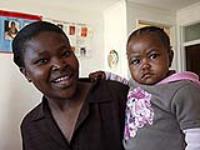
Mother and baby in Lesotho Credit: UNAIDS/M. Hamman
In sub-Saharan Africa an estimated 60% of people living with HIV are women, mostly in the reproductive age group. In the absence of appropriate interventions, HIV infection in women translates directly to infant and child infections.
Each year approximately 1.4 million women living with HIV become pregnant. Among antenatal clients in sub-Saharan Africa, the proportion of women living with HIV ranges from 5% to as high as 30%—and HIV among childbearing women is the main cause of infection among children.
More than 90% of infant and young child infections occur through mother-to-child transmission, either during pregnancy, labour and delivery, or breastfeeding. Without intervention, about one in three children born to mothers living with HIV will become infected.
In 2008, 430,000 children were newly infected with HIV, 90% of whom lived in sub-Saharan Africa. Most of these children, in the absence of access to antiretroviral treatment will die within one year of birth. Those who survive often lose their parents, if they too do not have access to antiretroviral therapy.
However the lives - of mothers and their babies—can be saved, through a combination of HIV testing and counselling, access to effective antiretroviral prophylaxis and treatment, safer delivery practices, family planning, and safe use of breast-milk substitute.
Investments made to protect mothers from HIV and babies from becoming infected is a moral responsibility of all governments.
Michel Sidibé, UNAIDS Executive Director
UNAIDS Executive Director Mr Michel Sidibé has called for the elimination of mother-to-child transmission of HIV by 2015. Africa is responding to this call. This week more than 200 participants from 20 countries with the highest burden of infections among pregnant women are meeting in Nairobi to chart out a a course of action to the needed HIV services.
At the heart of the plan is to mobilize resources. UNAIDS, UNFPA, WHO, UNICEF and the Global Fund to Fight AIDS, TB and Malaria (Global Fund) are co-convenors of this meeting will be providing technical support to these countries in building their capacities to develop sound business plans that can be funded.
“Africa‘s leaders are becoming serious about protecting their future generations,” said Michel Sidibé. “Investments made to protect mothers from HIV and babies from becoming infected is a moral responsibility of all governments.”
The Global Fund is an important source for these resources. It has committed to working with countries and other partners to ensure that at least 80% of Global Fund supported prevention of mother-to-child transmission (PMTCT) programmes meet the requisite levels of efficacy and quality by December 2010. The Global Fund has also committed to accelerate the scale up of PMTCT programmes and extend coverage to at least 60 per cent of women in need globally by the end of 2010.
A first step is to help countries reprogramme their existing grants to improve the effectiveness of the current programme strategies as well re-direct resources from savings and efficiency gains. The second step is preparing countries to make quality submissions to the Global Fund’s round 10 call for applications.
Many countries are already doing so. Ethiopia, having identified low antenatal coverage as a bottleneck to PMTCT utilization, is using its US$ 600 million grant to strengthen its maternal and child health services. South Africa has used the reprogramming opportunity to strengthen the participation of civil society in the PMTCT reprogramming exercise. Nigeria is using its reprogramming opportunity to strengthen broad program coverage and set more ambitious targets, much needed as Nigeria has the largest PMTCT burden globally. Zambia and Ghana also raised US$ 3 million from the Global Fund.
UNAIDS together with its Cosponsors UNICEF and WHO have facilitated such reprogramming in Tanzania which helped the country to mobilize an additional US$ 2.2 million for the country’s PMTCT programme. As a result the country increased its target coverage to 70%.




